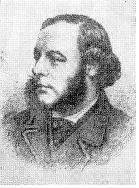Died January 27, 1880 Occupation Architect Parents Charles Barry | Name Edward Barry Role Architect Siblings Charles Barry, Jr. | |
 | ||
Structures Royal Opera House - L, Royal Opera House - V, Halifax Town Hall, Great Ormond Street Ho, Fitzwilliam Museum Similar People Charles Barry, John Wolfe Barry, George Basevi, Charles Robert Cockerell, Edward Blore | ||
Edward Middleton Barry RA (7 June 1830 – 27 January 1880) was an English architect of the 19th century.
Contents

Biography

Edward Barry was the third son of Sir Charles Barry, born in his father's house, 27 Foley Place, London. In infancy he was delicate, and was placed under the care of a confidential servant at Blackheath. At an early age he was sent to school in that neighbourhood, and then to a private school at Walthamstow, where he remained until he became a student at King's College London.
He was apprenticed to Thomas Henry Wyatt for a short time, after which he joined his father's practice. He continued to assist his father until the latter's sudden death in 1860, but he had already made considerable progress in working on his own account. In 1848 he had become a student at the Royal Academy, and even while assisting his father found time to devote to works of his own. The first of these was St. Saviour's Church, Haverstock Hill, in 1855–56. His designs for St. Giles's schools, Endell Street, which were carried out under his own superintendence in 1859–60, gave him a recognised position. It was to the originality displayed in these works that he owed his admission, in 1861, as an associate to the Royal Academy.
The reconstruction, in 1857, in the short space of eight months, of the theatre at Covent Garden, which had been destroyed by fire, and the erection in the following year of the Floral Hall adjoining, afford examples of his energy, constructive skill, and artistic ability. These works were executed for his own private clients, and without diminishing the assistance which he was then rendering to his father. In 1860 Sir Charles Barry died suddenly, and upon Edward devolved the duty of completing his father's works. Foremost of these was the new Palace of Westminster, which was at length entrusted to him by the government; and Halifax Town Hall.
On 29 March 1862 he married Lucy, daughter of Thomas Kettlewell. The remaining years of his life record a long series of works designed by him, many of them of national magnitude and importance. In 1869 he was elected an academician, and in 1873, on the retirement of Sir George Gilbert Scott, and then again in 1878 he was elected professorship of architecture in the Royal Academy. In 1874, on the resignation of Sydney Smirke, he was appointed treasurer of the academy.
Significant contributions
Among his most significant contributions to London’s architectural scene is the Theatre of the Royal Opera House in Covent Garden. The previous theatre (built by Robert Smirke in 1809) was destroyed in a fire in 1857. Edward Barry was commissioned to design the new "Royal Italian Opera" as it was then known, completing it for its official opening on 15 May 1858. He also designed the adjacent Floral Hall, a glass and cast iron structure heavily influenced by the Crystal Palace built for the Great Exhibition of 1851. The Covent Garden work was hugely influential in Barry’s appointment to design the Royal Opera House in Valletta, Malta (1866), bombed by the Luftwaffe during the Second World War. Barry often favoured a very classical style.
Other projects
Final works
Towards the end of his life, Barry began working with his eldest brother, Charles Barry, Jr.. Among the projects jointly attributed to them are new chambers at Inner Temple, London (completed in 1879), and the design of the Great Eastern Hotel at London’s Liverpool Street station, completed in 1884, after Edward's death.
